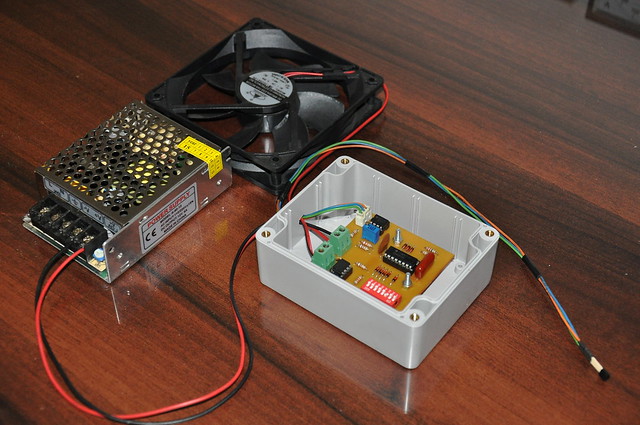In this post, we describe the fan controller which we designed for our 9U wall mount server cabinet. This fan controller is designed to drive a 12V DC cooler fan with pre-configured intervals or by monitoring the temperature of the server cabinet.
Core components of this fan controller are CD4060 binary counter, LM35 temperature sensor, and LM358 operational amplifier. In this design, CD4060 has used as long duration timer and it can be configured to trigger cooler fan from 1-minute and up to 4-hour.
In this design, an LM35 temperature sensor is used to activate cooler fan in specified temperature. This sensor stage is useful to drive cooler fan when timer stage is in an inactive state.
To control the cooler fan we use AP9971 dual N-channel power MOSFET transistor. We design this system to drive 12V cooler fans up to 2A of current. To test this controller we use commonly available 120mm × 120mm, 12V - 300mA brushless DC fan. In our server cabinet, we mount this fan to push hot air out of the cabinet.
This fan controller is designed to work with 12V - 1A (or higher) power supply. For the testing and for the final installation, we use 12V - 60W power supply unit which is commonly used for LED lighting projects.
Supplied PCB design of this controller is 64mm × 63.5mm and is based on standard through-hole type components. All the PCB designs and schematic of the controller is available to download at google drive or from easyeda.com.
 |
| The final version of the fan controller with DC brushless fan and 12V - 60W PSU. |
Core components of this fan controller are CD4060 binary counter, LM35 temperature sensor, and LM358 operational amplifier. In this design, CD4060 has used as long duration timer and it can be configured to trigger cooler fan from 1-minute and up to 4-hour.
In this design, an LM35 temperature sensor is used to activate cooler fan in specified temperature. This sensor stage is useful to drive cooler fan when timer stage is in an inactive state.
To control the cooler fan we use AP9971 dual N-channel power MOSFET transistor. We design this system to drive 12V cooler fans up to 2A of current. To test this controller we use commonly available 120mm × 120mm, 12V - 300mA brushless DC fan. In our server cabinet, we mount this fan to push hot air out of the cabinet.
This fan controller is designed to work with 12V - 1A (or higher) power supply. For the testing and for the final installation, we use 12V - 60W power supply unit which is commonly used for LED lighting projects.
 |
| 3D view of the fan controller PCB. |
Supplied PCB design of this controller is 64mm × 63.5mm and is based on standard through-hole type components. All the PCB designs and schematic of the controller is available to download at google drive or from easyeda.com.
Comments